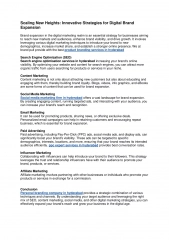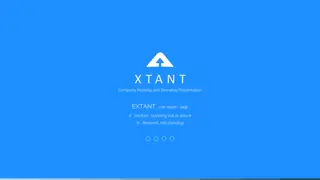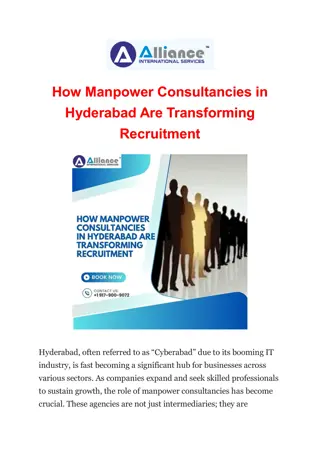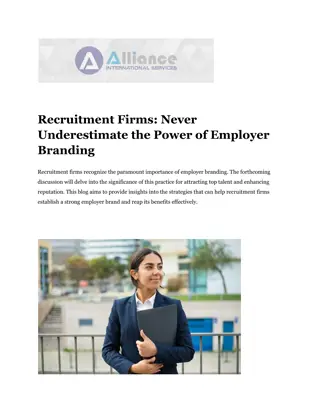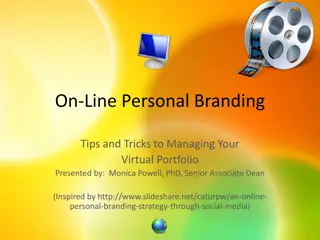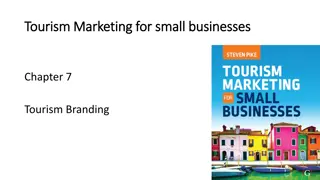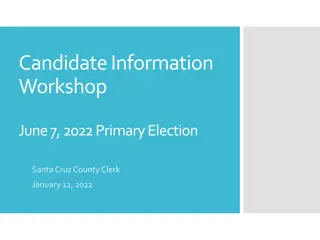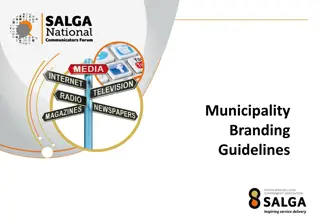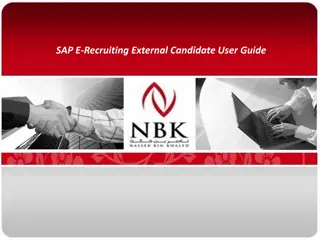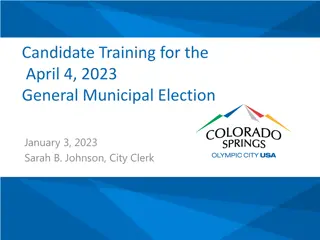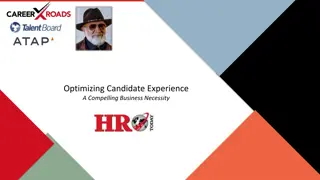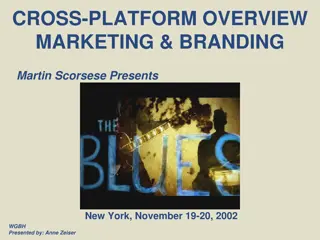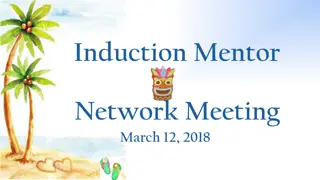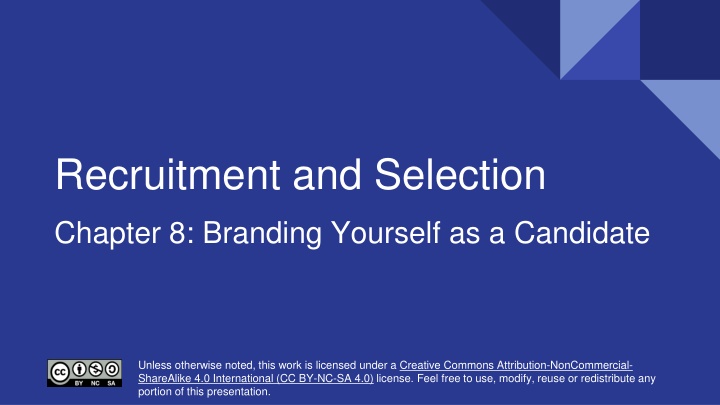
Branding Yourself as a Candidate: Unleashing Your Potential
Explore the journey of personal branding and self-discovery to enhance job satisfaction. Identify your values, skills, and interests to set yourself apart from other candidates. Learn how to craft a compelling elevator pitch, utilize social media for networking, and develop a job search strategy aligned with your personal brand.
Download Presentation

Please find below an Image/Link to download the presentation.
The content on the website is provided AS IS for your information and personal use only. It may not be sold, licensed, or shared on other websites without obtaining consent from the author. If you encounter any issues during the download, it is possible that the publisher has removed the file from their server.
You are allowed to download the files provided on this website for personal or commercial use, subject to the condition that they are used lawfully. All files are the property of their respective owners.
The content on the website is provided AS IS for your information and personal use only. It may not be sold, licensed, or shared on other websites without obtaining consent from the author.
E N D
Presentation Transcript
Recruitment and Selection Chapter 8: Branding Yourself as a Candidate Creative Commons Attribution-NonCommercial-ShareAlike 4.0 International (CC BY-NC-SA 4.0) Creative Commons Attribution-NonCommercial-ShareAlike 4.0 International (CC BY-NC-SA 4.0) Unless otherwise noted, this work is licensed under a Creative Commons Attribution-NonCommercial- ShareAlike 4.0 International (CC BY-NC-SA 4.0) license. Feel free to use, modify, reuse or redistribute any portion of this presentation.
Learning Outcomes By the end of this chapter, you will be able to: Identify your personal values and understand how they will influence your job satisfaction. Assess your industry-specific and transferable skills and articulate how they will set you apart from other candidates. Develop STAR responses and accomplishment statements to respond to common situational interview questions Formulate an elevator pitch that sells your strengths and accomplishments as a worker. Utilize social networking and social media platforms to assist in networking. Create a job search strategy that seeks positions that align with your values, industry specific skills and aligns with your personal brand. Engage in professional development to continuously refine your professional appearance and presentation.
8.1 Introduction Personal branding is one s story. The first step to reaching your ultimate success and job satisfaction begins with a process of self-discovery. By taking the time to explore your own interests, values, skills, work preferences, and accomplishments, you will not only become more self-aware and self- assured in your career decision making, but you will also be able to articulate your strengths to employer. Image by SDRC, used under fair dealing for purposes of education
8.1 Introduction cont. What are your Interests, Values, Skills, and Accomplishments? Interests Values What do you enjoy doing? What motivates you to get out of bed in the morning? What jobs have you enjoyed the most and why? Do you enjoy challenging work? Do you enjoy independence in the workplace? Is recognition for your accomplishments necessary for fulfillment? Do you need variety in your daily tasks? Skills Accomplishments What technical and industry specific skills do you possess? What have you learned in academia, or from previous jobs? What transferrable skills do you possess? Are your communication skills strong? Are you a good problem solver? What contributions have you made to group projects? What recognition have you received from peers, instructors, customers, etc. about your performance?
8.2 Communicating Your Skills So far, you ve taken an inventory of your skills and begun to consider the ways in which some of those skills might be transferable. Now you need to know how to communicate them. The STAR method is an acronym that stands for: Situation What was the situation? What problem needed to be solved? Task What was your Task? Action What action did you take, step by step? Result What was the result? (i.e., what was accomplished, improved, or learned)
8.2 Communicating Your Skills II Using the STAR method ensures that you demonstrate the skills you have in a clear and focused manner. Sample question: Can you give me an example of a time you resolved a conflict between employees? Situation: In my previous HR role, two team members were consistently clashing over project responsibilities, which was affecting their productivity and the team s morale. Task: My task was to mediate the conflict and help them find a way to collaborate effectively. Action: I met with each employee individually to understand their perspectives, then brought them together for a mediation session. I facilitated a discussion where they could express their concerns and guided them in setting clear expectations for their roles. Result: By the end of the session, they had reached a mutual agreement on how to divide responsibilities, and their working relationship improved. This not only resolved the immediate conflict but also enhanced team collaboration moving forward
8.2 Communicating Your Skills III Now that you are familiar with the star method, let s talk about accomplishment statements. An accomplishment statement is your STAR story distilled down into one phrase. Here is the simple formula for an accomplishment statement: VERB + CONTEXT+RESULT Let's say you want an accomplishment statement to support your organization skills, accuracy, and/or database skills. You think of an example: You had to track employee vacation days (context), and so you organized (verb) a database, and you were commended for its accuracy (result). Your accomplishment statement could be: Organized database to track employee vacation days and was commended for accuracy
8.3 Selling Yourself When a company has designed a new product or brand, it is excited to let people know about it. The more enthusiastically it shares the news, the better the payoff. The same should be true of your job search. You are a new brand that is about to go on the market, you know you have unique qualities to offer, and you should be excited to let other people know about this too! Networking The Hidden Job Market For many of us, just thinking about networking can make us break out into a cold sweat. Even though we know that networking is a necessary component of uncovering the hidden job market, many of us still find it uncomfortable and question whether what we are doing is right. However, networking is the simple act of exchanging information, specifically for the purpose of forming and building relationships. The hidden job market, which according to Statistics Canada accounts for 65-80% of available jobs, suggests that an unprecedented number of jobs are no longer being publicly posted. More often than not, positions are being filled internally, by referral, or through direct contacts.
8.3 Selling Yourself II Networking is personal, so make a list of all the people you know with whom you can network. Don t disqualify anyone because you think they can t help. You never know who knows someone who might be the link to your next job. Write down the four Fs Family, Friends, Friends Families, and Families Friends, make use of a format like the table below. Name Relationship E-mail Phone Date of Contact Follow-Up Date Manny Romero mromero@craneinc. com 616-787-9121 March 4 Need to touch base again at end of the month Dad s friend at Crane, Inc. Shalee Johnson Hairstylist Not available; will talk to her on my next appointment 616-765-0120 April 7 To be determined based on first contact Rajesh Sumar Director of Alumni Relations at school Rahesh.sumar@coll ege.edu 891-222-5555 March 12 To be determined based on first contact
8.3 Selling Yourself III Online professional social networks such as LinkedIn, Facebook, and Twitter can help you expand your network and build relationships with many people who might be able to help put you in touch with the right people. Your social networking pages represent your personal brand. Be sure all words pictures, and videos are appropriate for viewing by prospective employers. Use the following tips to create an effective profile that will help you stand out: Produce a targeted and attractive headline. Increase your views with a good photo. Look directly at the camera and smile. Build a conversational and informative summary. Ask yourself what you want your target audience to know about you. Show your experience. These can reflect the STAR technique or Accomplishment Statements you have used to develop your resume descriptions. Share your accomplishments. Showcase your education. List all your post-secondary education. Build your connections by common interests and community Stay active!
8.3 Selling Yourself IV The elevator pitch One of the first steps in preparing for any networking situation is knowing what you want to say. The first question that is asked at almost every job interview is Tell me about yourself. If you attempt to improvise, you will likely start your interviews off on the wrong foot. On the other hand, a good elevator pitch allows you to direct the conversation towards your strengths (your brand!). To prepare your pitch, ask yourself the following questions: Who are you? Introduce yourself and provide a brief overview of your current academic or employment status. What experience and skills do you have? What makes you unique in these regards? What are you looking to do? Make a connection between your skills and career goals and what the company is seeking. What are your next steps? Connect on a social network like LinkedIn, even if you don t get the position. That connection can strengthen your network.
8.3 Selling Yourself V Best Practices for Applying for a Job via Email 1. Review your resume and cover letter to ensure they are correct and error-free. 2. Name each file in a way that makes it clear what the document is, usually with your name and the job that you applied for, such as MelanieFanshawe.docx 3. Unless otherwise directed, save the documents in MS Word format. 4. Enter a clear, short subject line, usually with your name and the job applied for, such as Melanie Hapke application for VP of Human Resources . 5. Compose a short message Begin with a salutation, follow with a statement addressing the job you are applying for and how you learned of it, then a short impactful statement detailing your qualifications, express your enthusiasm for the opportunity, and a complementary closing term such as sincerely . Add the recipients email last, to avoid accidentally sending the email before you re finished composing it!
8.4 Mastering Your Interview You ve been invited to an interview Congratulations! You ve already put a lot of work into getting to this point, so now let s examine strategies to help you get the job. You cannot control the interview s outcome, but you can control the preparation that goes into it. Knowing what to expect and preparing for those situations will put you in the best possible position to let your brand shine. Here are ten steps to guide you through preparation, the interview, and afterwards: 1. Be Ready to Show and Tell Prepare answers to common questions that highlight your skills and uniquity. 2. Accept and Confirm your Interview Do you have the correct time, date and address? Make sure you don t have any conflicting obligations.
8.4 Mastering Your Interview II 3. Research the Company and Your Interviewer - Research the job description and spend time on the company website reviewing their values and mission statement. If you know who your interviewer will be, research them chances are they have a LinkedIn profile. 4. Rehearse Your Elevator Pitch Do not be surprised if the first question asked during your interview is tell me about yourself. 5. Prepare Answers to Popular Interview Questions While there is no way to know what questions you will be asked, preparing answers to enough commonly asked questions will ensure you have a prepared answer to several of your interview questions. Forgo asking about salary expectations until the topic is brought up by an interviewer, and don t lead with negotiation wait until they ve provided a starting figure, if you need to answer compensation that falls within the standard salary range for the industry. is a safe answer. If asked about previous jobs, don t disparage your past experiences, even if you didn t enjoy the job in question. Such an answer can make you appear uncooperative. Make sure to end your response on a positive note such as I m ready for the challenges of my next job.
8.4 Mastering Your Interview III 6. Prepare Your Questions Toward the end of the interview, every interviewer will ask if you have any questions for them. Have several prepared such as: What skills make the most successful employees here? What is the top priority of someone who accepts the job? What is your favourite part of working for this organization? What would the ideal person for this position look like? What are the next steps in the hiring process? 7. Prepare for the Logistics Ensure you know how to get to the interview location and where in the building the interview will be conducted. Depart early in case you get lost, or traffic is uncooperative. 8. Professional Image Your wardrobe is part of your personal branding, dress professionally for your interview, even if the position allows casual dress while working.
8.4 Mastering Your Interview IV 9. Make a Personal Connection During the Interview People want to hire people they like. Be sure to send the night nonverbal messages while answering. Be aware of behaviours such as: Smiling, Eye contact, Handshakes, Gesturing, Nodding or shaking your head, Facial expressions, Posture, Nervousness, and active listening. 10.Follow-up, Follow-up, Follow-up Follow up contact can set you apart from other candidates. Write a thank you letter on the same day. Ask for a response timeframe and follow up with a phone call if you haven t heard back after that time. Hiring decisions can be delayed for reasons out of your control and not hearing back within a stated period is not always an indication that you were not selected for the position.
8.4 Mastering Your Interview V Building Your Brand: Becoming a Careerpreneur As fewer permanent jobs become our reality, we need to create our own successes and generate new opportunities. We need to take direction of our futures by being Careerpreneurs. This is an idea where you manage your own career path like a small business. Instead of waiting for your future to magically fall into your lap, it becomes imperative that you build and maintain a network of contacts, develop your own personal brand, and maintain an active online presence. Graduates today will experience more job changes than past generations; By gaining a broader range of experience through different roles, you will diversify your skill sets while becoming more adaptable to new challenges.
Key Takeaways: Personal Branding: A combination of your Skills, Values, Interests and Accomplishments that uniquely define you as a candidate. Communication of Your Skills: Understanding the expected formatting of responses to interview questions and crafting them to effectively communicate your abilities in a way that is superior to other candidates. Networking: Communicating with peers, friends, family, and professional acquaintances to find opportunities that are not publicly available. Social Networking: Making use of technology to network digitally. Mastering Interview Skills: Punctuality, presentation, understanding the company you are applying for, having rehearsed answers to common questions, and other components of interview etiquette will demonstrate your commitment to demonstrating your personal brand.
Key Terms Interests: Your likes and dislikes. Values: The facets of your workplace experience that bring you enjoyment and satisfaction. Skills: The learned abilities that assist your job performance. Accomplishments: Your workplace successes. STAR Method: An acronym of Situation, Task, Action, Result that outlines necessary points to cover in a response to a situational question. Accomplishment Statement: A condensed response to a situational question outlining your successes in that situation. The Hidden Job Market: The portion of available job positions that are not publicly advertised and only available to candidates who are networked into the positions.
Key Terms II Elevator Pitch: A statement that summarized your goals, talents, and other distinguishing traits as a candidate. Careerpreneur: The mindset of treating your career path as a business rather than a result of repeated happenstances.


